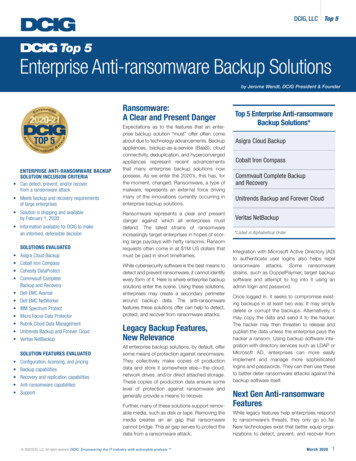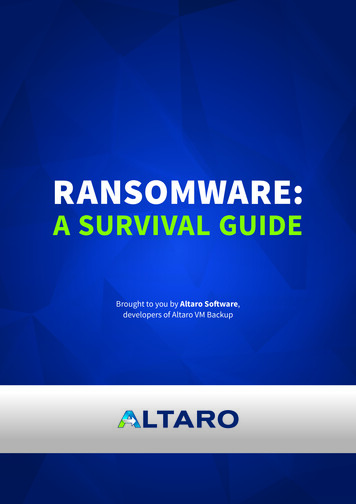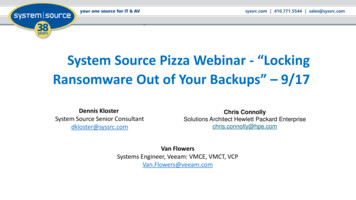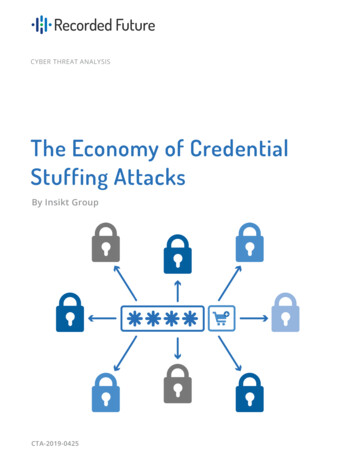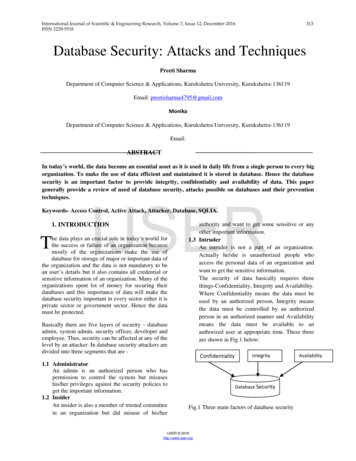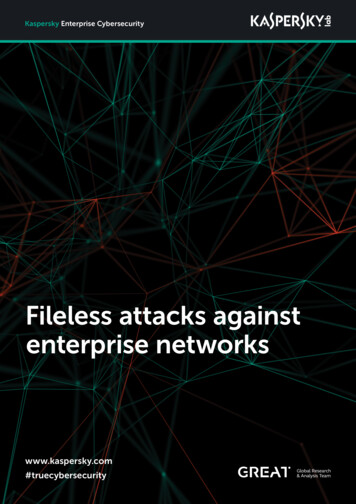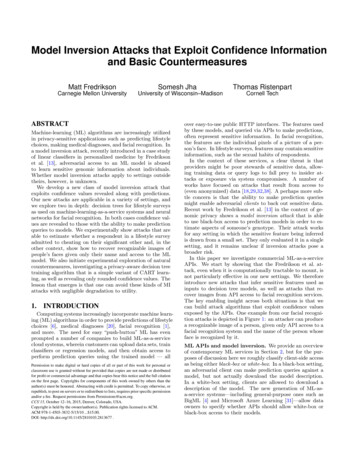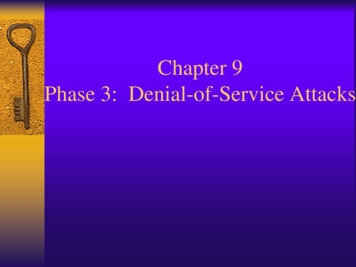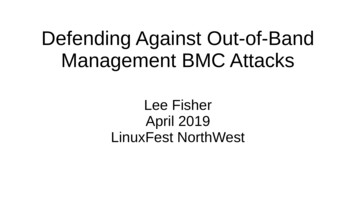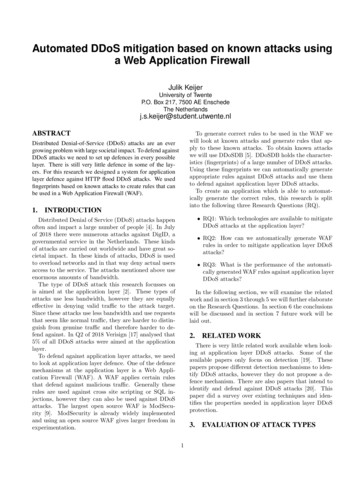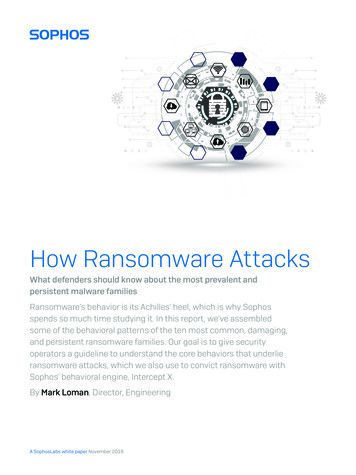
Transcription
How Ransomware AttacksWhat defenders should know about the most prevalent andpersistent malware familiesRansomware’s behavior is its Achilles' heel, which is why Sophosspends so much time studying it. In this report, we've assembledsome of the behavioral patterns of the ten most common, damaging,and persistent ransomware families. Our goal is to give securityoperators a guideline to understand the core behaviors that underlieransomware attacks, which we also use to convict ransomware withSophos' behavioral engine, Intercept X.By Mark Loman, Director, EngineeringA SophosLabs white paper November 2019
How Ransomware g ransomware into categories3444Cryptographically signed code4Privilege escalation (and lateral movement)5Network first7Multi-threaded7File encryption8Rename8Key blob9Wallpaper9Vssadmin9BCDEdit10Cipher100 allocation10Flush buffers11Encryption by proxy11OverviewColor codingWannaCryCharacteristicsWannaCry file system activityMatrixCharacteristicsMatrix file system activityA SophosLabs white paper November b file system activitySamSamCharacteristicsSamSam file system activityDharmaCharacteristicsDharma file system activityBitPaymerCharacteristicsBitPaymer file system activityRyukCharacteristicsRyuk file system activityLockerGogaCharacteristicsLockerGoga file system activityPartial encryptionMegaCortexCharacteristicsMegaCortex file system activityRobbinHoodCharacteristicsRobbinHood file system 24242425252526262627CharacteristicsSodinokibi file system activity2728Indicators of Compromise (IOCs)282
How Ransomware AttacksIntroductionMost blogs or papers about crypto-ransomware typically focus on the threat’s delivery,encryption algorithms and communication, with associated indicators of compromise(IOCs). This research paper takes a different approach: an analysis of the file systemactivity or behaviors of prominent crypto-ransomware families (hereafter, simply calledransomware).Ransomware creators are acutely aware that network or endpoint security controls posea fatal threat to any operation, so they've developed a fixation on detection logic. Modernransomware spends an inordinate amount of time attempting to thwart security controls,tilling the field for a future harvest.It's a lot easier to change a malware’s appearance (obfuscate its code) than to change itspurpose or behavior, and ransomware always shows its tell when it strikes. The increasingfrequency with which we hear of large ransomware incidents indicates that the codeobfuscation techniques ransomware now routinely employs, such as the use of runtimepackers, must continue to be fairly effective against some security tools, otherwise theransomware makers wouldn't use them.It's important to recognize there's hope in this fight, and a number of ways admins canresist: Windows 10 Controlled Folder Access (CFA) whitelisting is one such way, allowingonly trusted applications to edit documents and files in a specified location. But whitelistingisn't perfect – it requires active maintenance, and gaps or errors in coverage can result infailure when it's most needed.A SophosLabs white paper November 20193
How Ransomware AttacksRansomwareTraitsCriminals are constantly releasing new ransomware variants. To endpoint protection productsthat rely on static analysis, these new variants bear no resemblance to earlier samples. Aswith other forms of malware, ransomware creators apply runtime packers to the ransomwareprogram, helping to conceal its purpose and avoid detection until it has completed its coretask.In most cases, ransomware creators use proprietary, non-commercial packers that thwartautomated unpacking routines used by endpoint protection software, making it harder toclassify and determine the intention of the packed executable, as well as more difficult forhuman analysts to reverse engineer.There are behavioral traits that ransomware routinely exhibits that security software can use todecide whether the program is malicious. Some traits – such as the successive encryption ofdocuments – are hard for attackers to change, but others may be more malleable. Mixing it up,behaviorally speaking, can help ransomware to confuse some anti-ransomware protection.Dividing ransomware into categoriesFor this report we investigated several prominent ransomware families, and have categorizedthem into three categories, distinguishing them by the method attackers use to spread theinfection:1. Cryptoworm - A standalone ransomware that replicates itself to other computers formaximum reach and impact.2. Ransomware-as-a-Service (RaaS) – A ransomware sold on the dark web as a distributionkit to anyone who can afford it. These RaaS packages allow people with little technicalskill to attack with relative ease. They are typically deployed via malicious spam e-mails(malspam), via exploit kits as a drive-by download, or semi-manually by automated activeadversaries.3. Automated Active Adversary – Here, the ransomware is deployed by attackers who usetools to automatically scan the internet for IT systems with weak protection. When suchsystems are found, the attackers establish a foothold and from there carefully plan theransomware attack for maximum damage. For example, services that are openly exposedto the internet – like the Remote Desktop Protocol (RDP) – are a sought-after entry pointas they are susceptible to a brute-force password-guessing attack. Although victims maybelieve they are targeted, the attack is usually opportunistic.Cryptographically signed codeAttackers may attempt to minimize detection by security software by signing¹ theirransomware with an Authenticode certificate, which anyone can buy (or steal). Signedprograms are supposed to offer assurance that the code has not been modified since thesoftware company released it, but it offers no assurance that the software should even berunning in the first place. Unfortunately, some security tools conflate "digitally signed" with"should be allowed to run." When ransomware is properly code-signed, anti-malware or antiransomware defenses might not analyze the ransomware as rigorously as they would otherexecutables that lack a valid digital signature. Endpoint protection software may even chooseto trust the malicious code.¹ https://en.wikipedia.org/wiki/Code signingA SophosLabs white paper November 20194
How Ransomware AttacksNew code-signing certificates typically cost around 50. In addition to sharing paymentinformation, the certificate authority requires the person or organization purchasing thecertificate to supply contact details. The certificate authority contacts the purchaser viaemail and phone to validate their existence. While this is a hurdle and risk for many malwareauthors, more organized criminals make the effort to ensure their malware is code-signedwith a valid Authenticode certificate to prevent detection and help ensure success.Certificate issuers act quickly to revoke a signing certificate when they're notified that thecertificate is being used in the commission of a cybercrime. Once the certificate authorityrevokes the digital certificate, and it becomes very easy for endpoint protection software tolocate and quarantine all malware signed with the revoked certificate.Privilege escalation (and lateral movement)While it is good practice to give user accounts – and therefore the applications they run– limited access rights, in today’s threat landscape that doesn’t help much. Even if thelogged-in user has standard limited privileges and permissions, today’s ransomware usesexploits to elevate their own privileges and abuse stolen administrator credentials to makesure the attack is performed using a privileged account. Some examples:ÌÌ EternalBlue is an exploit² developed by the U.S. National Security Agency (NSA). It wasleaked and, later, used as part of the worldwide WannaCry ransomware attack in 2017.In conjunction with the DoublePulsar code injection technique, the exploit allows theinstallation of malware with the highest privileges on an endpoint, regardless of theprivileges of the logged in user.ÌÌ To suppress a User Access Control (UAC) prompt that normally occurs during privilegeelevation, some ransomware employs a UAC bypass exploit³ that sets the path to theransomware in a specific registry key. When this is set, running the Windows EventViewer process (eventvwr.msc, a Microsoft Saved Console file) will inadvertentlylaunch the ransomware (for example, Dharma and BitPaymer) with elevated privileges,regardless of the privileges of the logged in user. This exploit works for every version ofWindows until Windows 10 Creators Update (April 2017).ÌÌ CVE-2018-8453 is a Win32k Elevation of Privilege (EoP) use-after-free vulnerability.Malware that successfully exploits this vulnerability can run arbitrary code in kernelmode. For example, the malware can install programs; view, change, or delete data; orcreate new accounts with full user rights, regardless of the privileges of the logged inuser. The Sodinokibi ransomware, for example, exploits this vulnerability to elevate itsprivileges.Once the attackers compromise a server or endpoint, many active adversaries abuseexisting Windows tools, as well as open-source security or penetration testing tools. Forinstance, they might use TASKKILL.EXE to terminate processes belonging to endpointprotection software. They may even introduce a tool like Process Hacker to interactivelymake the machine their own. They’ll install a remote access tool (RAT) like CobaltStrike,Meterpreter, or PowerShell Empire for flexibility and to maintain persistence on theirfoothold machine until the mission is complete.² securitybulletins/2017/ms17-010³ ss-using-eventvwr-exe-and-registry-hijacking/A SophosLabs white paper November 20195
How Ransomware AttacksOnce the machine is owned, many attackers attempt to harvest a local domainadministrator’s credentials using a post-exploitation tool like Mimikatz. The attackers mayadd a new domain administrator account to the Active Directory (AD), just for them to use,in case the real domain admins change passwords.After the keys to the kingdom have been obtained, it's time to use them. Some activeadversaries use a tool called BloodHound⁴ to map the Active Directory domain anddetermine where the metaphorical crown jewels – servers or other high-value targets—arestored. Many attackers spend the time interactively looking for file servers and those usedfor data backups, as a corrupted or damaged backup leaves the victim more likely to agreeto pay the ransom.We've observed ransomware threat actors take over a server via the Remote DesktopProtocol (RDP), and destroy the backups via ransom encryption, or sometimes just bydeleting them normally. Lastly, they will distribute ransomware to peer endpoints andfile servers using those same domain admin credentials and the Windows softwaremanagement utility WMI.To automatically distribute ransomware to peer endpoints and servers, adversaries mayleverage a trusted dual-use utility like PsExec from Microsoft SysInternals. The attackercrafts a script that lists the collected targeted machines and incorporates them togetherwith PsExec, a privileged domain account, and the ransomware. This script successivelycopies and executes the ransomware onto peer machines. This takes less than an hour tocomplete, depending on the number of machines targeted. By the time the victim spotswhat’s going on it is too late, as these attacks typically happen in the middle of the nightwhen the IT staff is sleeping.As an alternative to PsExec, active adversaries have also been seen leveraging a logon andlogoff script via a Group Policy Object (GPO), or abusing the Windows Management Interface(WMI) to mass-distribute ransomware inside the network.Attackers have been observed leveraging stolen credentials for, or exploiting vulnerabilitiesin, remote monitoring and management (RMM) solutions like Kaseya⁵, ScreenConnect6,and Bomgar⁷. These RMM solutions are typically used by a managed service provider (MSP)that remotely manages its customers’ IT infrastructure and/or end-user systems. RMMsolutions typically run with high privileges and, once breached, offer a remote attacker“hands on keyboard” access, resulting in unwanted data hostage situations. With suchaccess, attackers can easily distribute ransomware into networks remotely, potentiallyhitting multiple MSP customers at once.It is important to enable multi-factor authentication (MFA) on central management toolsand leave Tamper Protection on endpoint protection software enabled. Active adversarieswill attempt to disable local protection services via tools like Process Hacker, but also try tolog in into central security portals to disable protection across the network.⁴ https://github.com/BloodHoundAD/BloodHound⁵ 35025⁶ tes-and-spam/⁷ iminals-turn-friends-into-enemies/a/d-id/1335778A SophosLabs white paper November 20196
How Ransomware AttacksNetwork firstTo ensure victims pay the ransom money, ransomware will try to encrypt as manydocuments as possible, sometimes even risking, or purposely crippling, the endpoint. Thesedocuments can be stored on local fixed and removable drives, as well as on mapped remoteshared drives. The ransomware might even prioritize certain drives or document sizesfirst to ensure success before being caught by endpoint protection software or noticed byvictims. For example, ransomware may be programmed to encrypt several documents atthe same time via multiple threads
Ì To suppress a User Access Control (UAC) prompt that normally occurs during privilege elevation, some ransomware employs a UAC bypass exploit³ that sets the path to the ransomware in a specific registry key. When this is set, running the Windows Event Viewer process (eventvwr.msc, a Microsoft Saved Console file) will inadvertently
